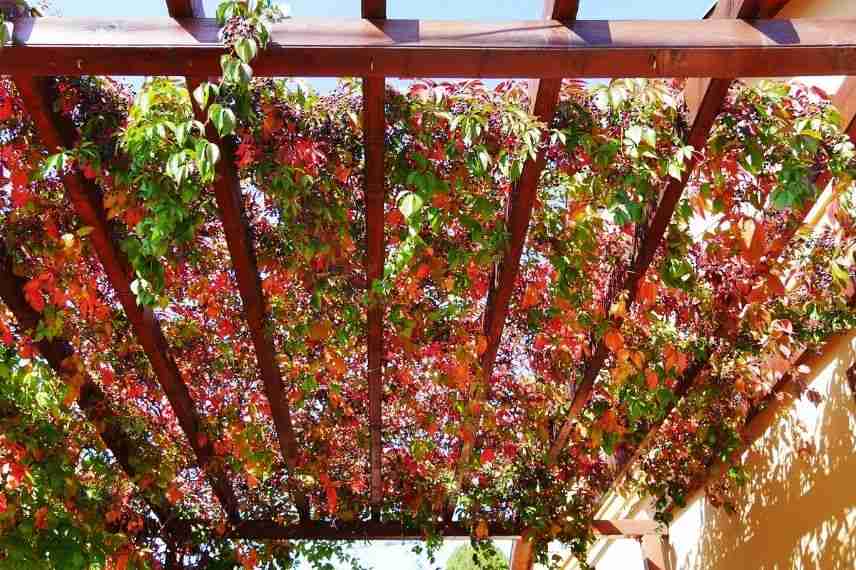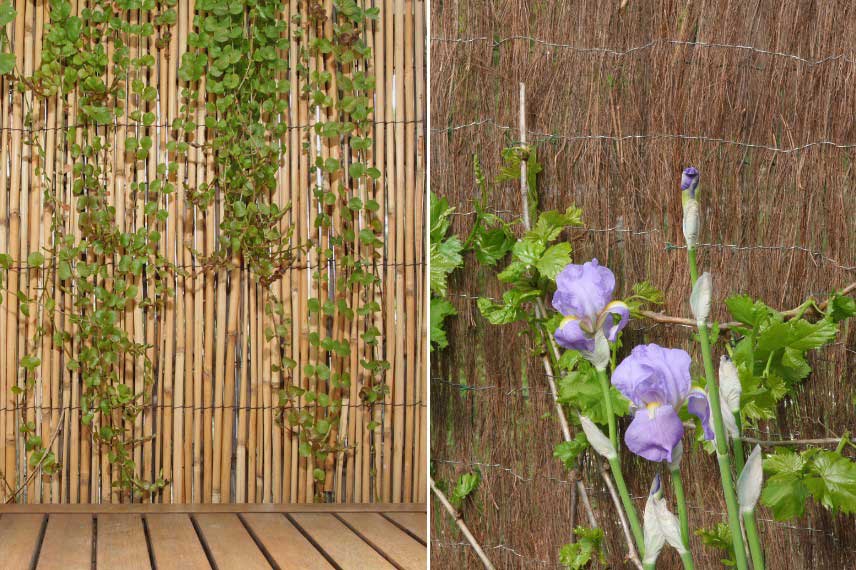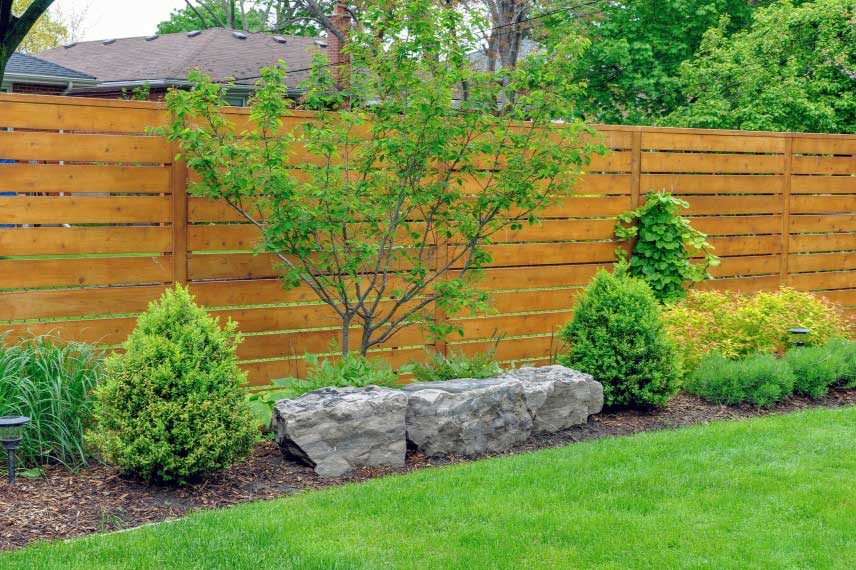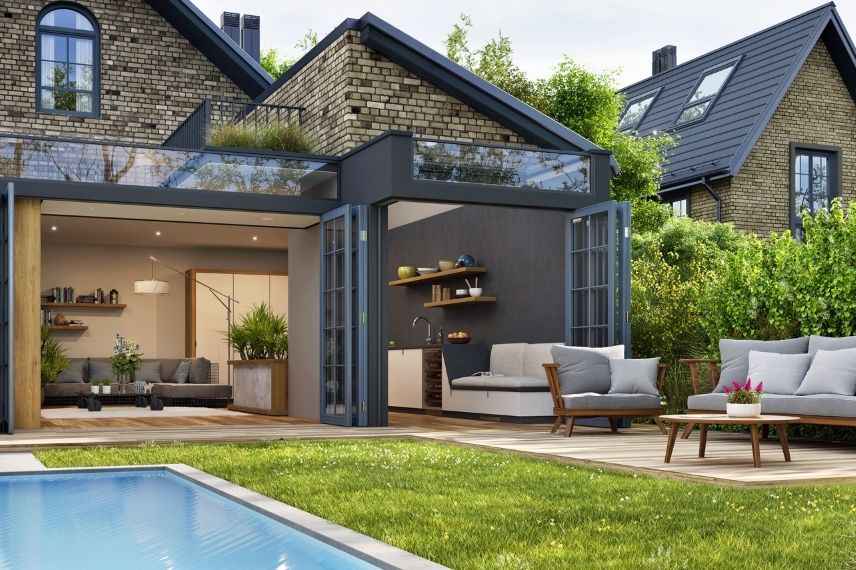
How to hide a high overlooking view in your garden?
6 solutions to hide the overlooking view
Contents
A view overlooking your garden, pool, terrace, or even your interior is never pleasant and can even lead to tensions. It may come from a building, a simple window on the nival zone, or offices in urban areas. You may be wondering how to hide an elevated view, or more specifically how to block the view from neighbours above, while maintaining the aesthetics of your outdoor space?
Fortunately, it is possible to block the view and protect yourself from an overlooking view, to recreate a cocoon sheltered from prying eyes. Whether you need to hide a garden view from above, block a view from a two-storey house, or simply shield yourself from neighbours in case of an overlooking view, there are both plant-based and structural solutions to address your issue.
We offer you 6 ideas for privacy screens, either durable or seasonal, including the choice of a tree to block the view or a screening tree, capable of integrating harmoniously into your garden. Each solution helps you to effectively hide a view in the garden, according to your needs, budget, and environment!

Create a plant screen to block the view from neighbours above.
You are looking for how to hide the view from neighbours at height? Climbing plants are perfect for adding verticality to the garden. They naturally shield you from prying eyes without too much hassle.
The choice of a climbing plant will, of course, depend on your growing conditions: exposure (sunny, shady, windy…), soil type (sandy, clayey, chalky…), location (coastal, mountainous…), winter hardiness, etc.
Prefer fast-growing, vigorous, and sturdy plants that are hardy enough for your climate and easy to grow for minimal maintenance. Also, opt for plants with dense foliage for better screening.
Climbing plants can be grown in pots, trained, or espaliered. In a small space, on a terrace or balcony, you can easily grow several pots side by side to create a tall green wall. In the ground, in the garden, climbing plants can rise on posts, fences, trellises, wire mesh, pergolas, or other tall supports to create a true protective screen.
If you need to protect yourself from an overlooking view permanently throughout the year, choose varieties with evergreen foliage. For example, opt for ivy or honeysuckle. The passionflower, the jasmine or the trumpet vine will be evergreen in mild winters, not dropping below about -5°C.
If, on the other hand, you only need a privacy screen during the beautiful season, for the terrace, pool, or balcony, deciduous climbing plants or annual varieties will be more than sufficient. They will also have the advantage of allowing sunlight to filter through in winter. Choose between wisteria, clematis, climbing rose, hops, Virginia creeper or even morning glory.

Virginia creeper trained on a pergola
Read also
How to create a privacy hedge?Planting a screening tree to protect against an overlooking view
If you have enough space, planting a screening tree to protect yourself from an overlooking view is the solution. Choose robust species that are relatively fast-growing, easy to maintain, tolerant of pruning, and with dense foliage.
Opt for classics that are still effective, pines, cedars, cypresses, chamaecyparis, and other conifers with evergreen foliage that stays in place all year round. Olive trees and green oaks also make for aesthetic, natural, and durable screens. Palms or eucalyptus will add an exotic touch and a hint of jungle ambiance. A holly can also serve as a defensive and protective barrier in the garden. Hornbeams, poplars, and beeches have the advantage of allowing light to pass through in winter, if you do not need to shield yourself from prying eyes during that season.
Note that planting trees over 2 metres in height should be done further back than for smaller plants. Do not hesitate to consult the current legislation or our article “Planting trees and bushes: what does the law say?”.
Creating a hedge to screen a two-storey house from view
A hedge of bushes is an effective, natural, and cost-effective solution for screening a multi-storey house, for example. However, be sure to choose fast-growing bushes, so you don’t have to wait several years before your hedge effectively serves its role as a green screen. This hedge will also have the advantage of blocking the wind, providing shade, and promoting biodiversity.
As with climbing plants, you can opt for evergreen bushes, which provide cover all year round, or deciduous ones, allowing light to filter through in the off-season.
The bush hedge will require some maintenance, but choosing robust, tolerant varieties that are less susceptible to diseases will allow you to spend only a minimal amount of time on watering (which can even be automated), pruning, and annual upkeep. You can choose a single-species hedge or a mixed one, combining several different species.
The classics cotoneasters, thuyas, laurels or viburnums are widely used in gardens as privacy screens. However, there are many other bushes that make good candidates for this use: Japanese spindle trees, oleaster, photinias, escallonias, bamboos (to be paired with a rhizome barrier if choosing a running variety), photinias, aucubas, Mexican orange blossom, dogwoods, etc. Very aesthetic, some will even reward you with lovely flowering or decorative fruits, for an even more ornamental effect. Also consider grasses like miscanthus or stipas, which are increasingly used in gardens for their structural yet airy and light quality.
And if you’re having trouble deciding, go straight for our evergreen and privacy hedge kits.

A bamboo hedge is effective for blocking downward views.
Install a vertical screen to hide a view in the garden.
There are many solutions for quickly creating a privacy hedge at home. Easily found in DIY stores, garden centres, or to build yourself, they come in a variety of materials to suit all tastes and garden styles.
For a natural effect, opt for large bamboo, willow, or reed screens to hide from prying eyes in the garden. There are also options available in PVC. Natural screens, made from heather or coconut, are another solution. Easy to install and affordable, these visual barriers are, however, quite fragile and should be avoided in particularly windy situations.

On the left, a bamboo screen, and on the right, a heather screen.
Stronger but more expensive, trellises, fences, or panels also allow you to structure the space while recreating an area of privacy. You can install them on one side, facing the bothersome view. They are available in multiple materials (wood, composite, PVC, aluminium, etc.).
More permanent and requiring additional skills, building a low wall will also create a visual barrier between you and your neighbours. For a more decorative and less strict effect, feel free to play with paint colours and finishes, and to grow climbing plants to dress it up, etc.

Trellises or wooden fences are also a good solution for blocking the view. Don’t hesitate to plant bushes or large perennials in front of the screen.
Adopt modular solutions to better conceal a high overlook.
Some solutions have the advantage of being perfectly adaptable to the area to be concealed and can be easily moved. Blinds and parasols, or the more imposing marquees and party tents, have an effective screening effect, preventing your neighbours from looking into your home. They can be repositioned according to the seasons to hide an elevated view over the months. They also have the advantage of providing pleasant shade in summer.
Less bulky, very accessible, and just as effective, shade sails, draped or privacy screens, can lightly conceal a window facing a view, a terrace, or a balcony, while softening the space. They come in various shapes (square, triangle, rectangle) and have the advantage of being a lightweight and elegant screen that will gently sway with the wind, creating lovely warm light patterns.

Triangular shade sail to protect against prying eyes
Play with topography and landscaping to hide the view.
A carefully placed construction or installation can be enough to protect against an overlooking view. A well-oriented garden shed, for example, serves as a useful solution for storage or DIY as well as for creating a privacy screen. It will easily conceal a window with a direct view from above. If you wish to shield your pool from prying eyes, it is also possible to play with the location of the technical room.
We advise you to check the current regulations regarding any installation or construction near other homes and roads beforehand.
Highly valued in gardens, pergolas also help create volume and add height, allowing you to hide an overlooking view. Choose to let plants climb on them for a natural and aesthetic covering, providing better concealment.

Here, the extension of the house allows for hiding from the neighbour’s direct view
- Subscribe!
- Contents
































Comments